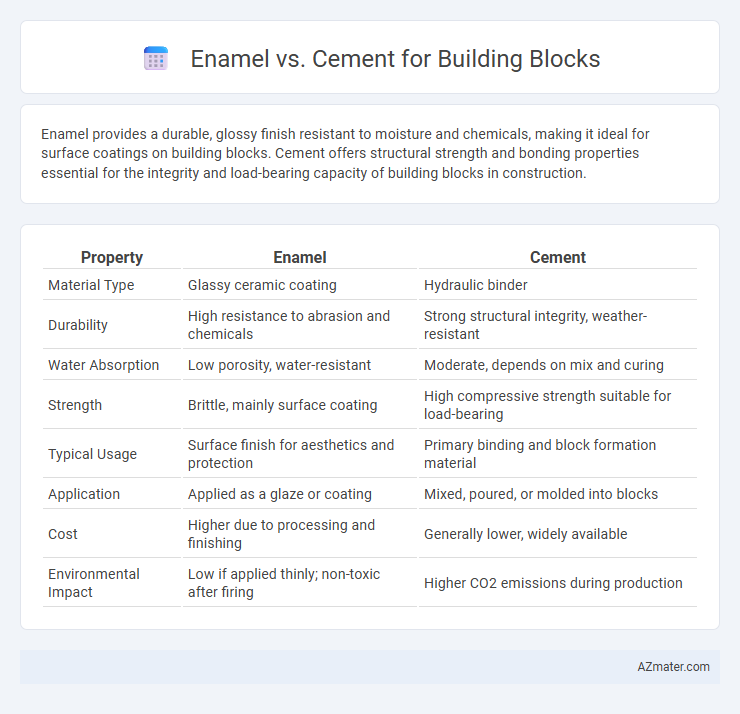Enamel provides a durable, glossy finish resistant to moisture and chemicals, making it ideal for surface coatings on building blocks. Cement offers structural strength and bonding properties essential for the integrity and load-bearing capacity of building blocks in construction.
Table of Comparison
| Property | Enamel | Cement |
|---|---|---|
| Material Type | Glassy ceramic coating | Hydraulic binder |
| Durability | High resistance to abrasion and chemicals | Strong structural integrity, weather-resistant |
| Water Absorption | Low porosity, water-resistant | Moderate, depends on mix and curing |
| Strength | Brittle, mainly surface coating | High compressive strength suitable for load-bearing |
| Typical Usage | Surface finish for aesthetics and protection | Primary binding and block formation material |
| Application | Applied as a glaze or coating | Mixed, poured, or molded into blocks |
| Cost | Higher due to processing and finishing | Generally lower, widely available |
| Environmental Impact | Low if applied thinly; non-toxic after firing | Higher CO2 emissions during production |
Introduction to Building Block Materials
Enamel and cement serve distinct roles in building block construction, with cement primarily used as a binding agent providing structural strength and durability. Enamel, a vitreous coating, is applied to blocks for protective and decorative finishes, offering resistance to moisture, chemicals, and wear. Understanding these materials' properties is essential for optimizing building block performance in various architectural applications.
What is Enamel: Definition and Properties
Enamel is a glassy coating fused onto building blocks through high-temperature firing, providing a durable, non-porous surface that resists moisture, stains, and corrosion. Its hardness and smooth finish enhance the block's longevity and ease of maintenance in construction applications. Unlike cement, enamel offers superior aesthetic appeal with vibrant colors and gloss while contributing to the structural protection of building materials.
What is Cement: Definition and Properties
Cement is a finely ground powder made from a mixture of limestone, clay, and other minerals, which acts as a binding agent when mixed with water, sand, and aggregates to form concrete or mortar. Its key properties include high compressive strength, durability, and the ability to harden and gain strength over time through a chemical process called hydration. Cement's versatility and strong adhesive qualities make it essential in construction for bonding building blocks, providing structural stability and longevity.
Durability: Enamel vs Cement
Enamel coatings provide a hard, glossy surface that resists scratches, chemicals, and moisture, significantly enhancing the durability of building blocks in harsh environments. Cement blocks, while structurally strong and load-bearing, are prone to surface wear, erosion, and can degrade over time when exposed to water without proper sealing. Choosing enamel over cement surface treatment optimizes long-term durability by combining chemical resistance with a protective barrier, extending the lifespan of construction materials.
Strength and Structural Performance Comparison
Enamel coatings on building blocks provide superior resistance to abrasion and chemical wear, enhancing surface durability but offering limited structural reinforcement. Cement-based blocks exhibit greater compressive strength and load-bearing capacity, crucial for foundational stability and overall structural integrity. While enamel improves block longevity against environmental factors, cement ensures essential strength for enduring architectural performance.
Aesthetic and Finish Differences
Enamel coatings on building blocks offer a glossy, vibrant finish that enhances aesthetic appeal through rich color depth and smooth surface reflections. Cement surfaces provide a matte, textured finish, contributing to a rugged, natural look valued for its understated elegance and durability. The choice between enamel and cement affects not only visual impact but also maintenance, with enamel offering easier cleaning due to its smoothness while cement provides a more breathable, weather-resistant facade.
Cost Analysis: Enamel vs Cement
Enamel coatings for building blocks generally incur higher upfront costs compared to traditional cement finishes due to specialized materials and application processes. Cement-based finishes offer a cost-effective solution with widespread availability and lower labor expenses, driving overall budget efficiency in large-scale construction projects. Long-term maintenance expenses for enamel can be lower because of its durability and resistance to environmental factors, potentially offsetting initial cost differences over time.
Environmental Impact and Sustainability
Enamel coatings on building blocks often involve energy-intensive manufacturing processes and the use of hazardous chemicals, contributing to higher environmental impact compared to cement-based blocks. Cement production is a major source of CO2 emissions, but innovations in low-carbon cement and the potential for incorporating industrial by-products enhance its sustainability profile. Using cement with recycled materials and optimizing block durability can reduce the overall carbon footprint, making sustainable cement blocks a viable alternative to enamel-coated options.
Maintenance and Longevity Considerations
Enamel coating on building blocks offers superior resistance to moisture, stains, and UV rays, significantly reducing maintenance frequency and extending the surface lifespan. Cement blocks provide robustness and durability but require periodic sealing and cleaning to prevent surface degradation and mold growth over time. Choosing enamel over cement enhances long-term aesthetic appeal and structural protection, minimizing repair costs and maintenance efforts.
Choosing the Right Material: Enamel or Cement
Choosing between enamel and cement for building blocks depends on the desired durability, appearance, and maintenance requirements. Enamel offers a smooth, glossy finish with excellent resistance to moisture and stains, ideal for decorative or interior applications. Cement provides superior structural strength and longevity, making it suitable for foundational and exterior uses where load-bearing capacity and weather resistance are critical.

Infographic: Enamel vs Cement for Building Block
 azmater.com
azmater.com